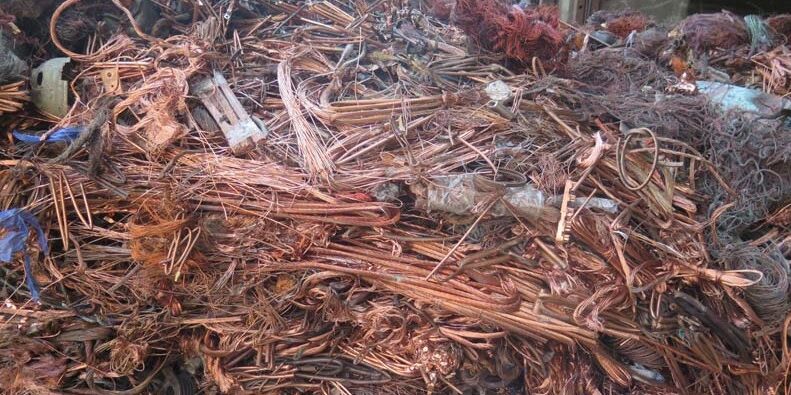US Copper scrap Exports rise as top Importers change and Domestic demand lags
While domestic copper demand has remained low, US exports of copper scrap continued to grow in 2022, rising 1.54% over 2021 levels, according to US International Trade Commission data
Over the course of 2022, US exports to Malaysia fell by 56.05% to 167,686 tonnes, down 93,990 tonnes from the previous year. This decrease was offset by increases in exports to China and India, which rose by 23.19% (up 60,893 tonnes) and 64.11% (up 37,034 tonnes), respectively.
“I think the only thing that kept the domestic market [afloat] was the export pricing in the last few years,” one source said on February 15. “Demand for 2022 has been on or off depending on the supply situation.”
Percentage-wise, Turkey, Belgium, Mexico and Thailand also made large gains, at 238.08%, 43.98%, 39.28% and 38.99%, respectively.
On the other hand, exports to Greece, Hong Kong and South Korea also decreased, by 35.22%, 32.65% and 17.02%, respectively.
“I think a lot of us expected to see China go crazy after getting out of lockdown, but it seems it is very sluggish.” the source continued.
Another source also echoed the sentiment that demand was “sluggish” in China.
Copper trade flows were suspended due to a series of Chinese policy changes leading to widespread uncertainty, but business eventually picked back up and US exports to China rose 233.78% over 2019 levels, with imports reaching 323,485 tonnes in 2022 compared with 96,917 tonnes in 2019.
In 2018, China’s State Council had announced it was working towards implementing a complete ban on imports of solid waste, including all metal scrap, by the end of 2020.
The rise of high quality copper scrap
In January 2020, the government released the list of renamed copper renewable materials, reclassifying high quality copper and brass scrap under new categories of renewable materials.
The Chinese Ministry of Ecology and Environment announced later that year that recycled copper and aluminium that met the country’s standards for renewable metals instead of solid waste could be freely imported into the country beginning in November.
At the time of the announcement, US sellers expressed wariness regarding the classification system and concerns that under the new policy, the thin line between ‘waste’ and ‘recyclable material’ was no longer determined by agencies run by the China Certification & Inspection Group (CCIC), which the industry was familiar with.
In November of 2022, the top ten copper producers in China sought to convince their government to relax scrap import standards, pledging to have recycled copper make up 25% of their total production by 2025, according to a joint statement by the ten producers.
Consumers in China have displayed a preference for overseas copper scrap over domestic material, with more consistency in quality and ease of obtaining tax rebates.
China’s market share of US exports totaled 10.07% in 2019 but has since climbed to reach 31.50% of the market share in 2022, outpacing the second highest importer of US scrap by nearly 20%.
“A lot of the time, the copper market moves on what is going on in China,” one trader said in November, prior to the lockdowns in China ending. The trader explained that with China being the biggest consumer of copper and metals in general, the country’s activity had the biggest influence on the copper market.
“If [China is] in lockdown and things are slowing down there, copper prices are more likely to go down. But if things are looking up and are not as bad as the day before, then copper prices will pick up as well,” he added.
Canada and India took the second and third largest percentages of the US market share at 11.57% and 9.23%, respectively. Both increased in 2022 but experienced some fluctuations between pre-Covid 19 pandemic 2019 and 2022.
India’s imports increased 64.11% from 2021 — up 43.59% from 2019 levels — to reach 94,803 tonnes in 2022.
Thailand also climbed, to 6.81% of the US market share, up from 2.34% in 2019, with tonnes taken in growing 210.44% since 2019, to 69,936 tonnes in 2022 — up from 50,319 tonnes the year before and 22,528 tonnes in 2019.
Mexico, Poland, Turkey and the United Arab Emirates also saw large percentage increases from pre-Covid 19 pandemic levels, with tonnage growing 208.98%, 204.74%, 163.72% and 117.11%, respectively.
Meanwhile, Malaysia’s market share has declined since 2019, despite remaining the top importer of US copper scrap from 2019-2020.
Malaysia accounted for 25.39% of US exports in 2019, but has since fallen to 7.18%, with the largest decline between 2021-2022.
The decrease has come following a 0% impurity scrap import policy that was enacted in 2022.
Malaysia’s new policy set higher restrictions than those for China, Indonesia and other scrap processing countries for major scrap import products including ”ferrous waste and scrap; remelting scrap ingots of iron or steel” (HS Code 7204), copper waste and scrap (HS Code 7404) and “aluminium waste or scrap” (HS Code 7602).
While market sources did not report the policy as causing a significant impact on pricing or market activity at the beginning of the year, exports to Malaysia began falling in March, with the 2022 total reaching 73,696 tonnes, down from 167,686 tonnes in 2021 and 244,370 tonnes in 2019.
Domestic copper scrap demand
North American copper sources have noted depressed domestic demand for quite some time, with the first source saying that, “export is the only thing keeping the spreads up.”
Since the start of 2023, sources have reported both declining export demand and continued slow domestic demand, citing some widening of discount spreads for copper scrap.
For most of 2022, the copper scrap No1 copper, discount, buying price, delivered to brass mill US remained unchanged at 9-11 cents per lb, first from January 26-September 28, 2022, and then, after a brief narrowing, the discount was again steady at 9-11 cents per lb from October 12-December 14.
However, following rising COMEX levels, prices shifted at the beginning of 2023, with the discount increasing to 10-13 cents per lb before settling back to 9-12 cents per lb, where it was last assessed on February 15.
While sources in 2022 noted that price movements were more affected by changes in export levels rather than COMEX levels, the combination of low export demand and rising COMEX levels led to some movement earlier in the year.
Additionally, while export did show some gains year on year, supply/demand imbalances persist, as does market uncertainty.
Speaking at the Institute of Scrap Recycling Industries Roundtables in September, John Gross, publisher of The Copper Journal, said, “Logically one would say, if we’ve got the market in a deficit position and we’ve got inventories almost nonexistent, the price should be a heck of a lot higher than it is. So why isn’t it? That’s an open-ended question and I don’t have an answer.”
However, brass demand has been more reactive to changes in exports, with sources noting more movement and more market activity.
“Domestic [demand] has been stronger on the brass side for us,” the first source said. “Copper is just very fickle, domestically.”
Throughout the year, brass sources noted more market activity, with one source saying at the end of 2022 that they were “still going from hand to mouth,” and that “what we’re producing, we’re shipping,” even in mid-to-late December.
However, sources did indicate in the week ended February 22 that in the wake of the fire at I. Schumann & Co’s facility there could be a temporary change in where brass scrap goes.
An explosion was reported at the company’s facility in Bedford, Ohio, on Monday February 20.
One source noted that, with the possible exception of yellow brass solids, due to Schumann’s facility being offline and other ingot makers trying to pick up as much of the slack as possible, “brasses won’t be export markets within two weeks.”
Fast markets last assessed the copper scrap yellow brass solids copper scrap yellow brass solids, buying price, delivered to brass ingot makers on February 22 at $2.59-2.67 per lb.
69 total views , 1 views today





